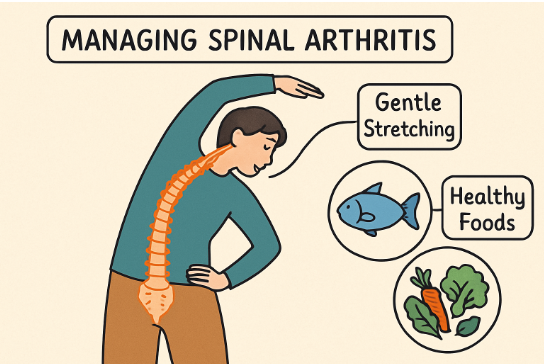Spinal arthritis affects millions, causing persistent pain, stiffness, and reduced mobility. While this condition can disrupt daily routines, the right strategies make a significant difference in managing symptoms and maintaining a fulfilling lifestyle. For those seeking professional help, exploring options like arthritis treatment Orange Park, FL can be an essential first step toward relief and improved function.
Managing spinal arthritis starts with understanding the condition and implementing a customized approach to care. By blending medical, lifestyle, and alternative techniques, minimizing discomfort and enjoying more active days is possible. Early intervention and exploring all available resources, including local treatment options and expert advice, offer hope and practical solutions for those affected by spinal arthritis.
Understanding Spinal Arthritis
Spinal arthritis, most commonly recognized as spine osteoarthritis, is marked by the gradual deterioration of cartilage within the facet joints of the back. The ongoing breakdown leads to pain, inflammation, and sometimes nerve impingement, manifesting as symptoms ranging from mild soreness to debilitating stiffness. Risk factors include genetic predisposition, age, excess weight, repetitive stress, and previous back injuries. Typical symptoms encompass lower back pain, reduced movement, and discomfort that often worsens with activity or prolonged periods of immobility.
Lifestyle Modifications
A proactive approach to everyday living is crucial for managing pain and protecting spinal health for the long term:
-
Regular Exercise: Moderate, low-impact exercises such as swimming, brisk walking, stretching, and yoga enhance core strength and spinal flexibility. They help ease pressure on painful joints and promote better posture.
-
Balanced Diet: Foods rich in anti-inflammatory nutrients—fruits (especially berries), leafy greens, oily fish high in omega-3s, and nuts—may help reduce inflammatory processes. Limiting ultra-processed foods and sugars can also help curb flare-ups.
-
Weight Management: Shedding excess pounds lessens the load on the spine, and even modest reductions can bring noticeable improvement in pain and day-to-day function.
Adopting these changes can provide benefits beyond the spine, supporting heart health and overall well-being. Many individuals see meaningful progress by blending structured exercise plans with attentive eating and weight control.
Medical Treatment Options
For persistent or severe discomfort, medical therapies may be warranted. Common options include:
-
Medications: Nonsteroidal anti-inflammatory drugs (NSAIDs) such as ibuprofen offer initial relief from pain and swelling. More advanced cases may be treated with prescription medications or corticosteroid injections, delivering temporary but sometimes substantial pain reduction. Some patients may also benefit from topical creams or opioid medications for short-term use under close supervision.
-
Physical Therapy: Tailored rehabilitative exercises prescribed by a physical therapist focus on increasing flexibility, improving posture, and strengthening core muscles. Therapy sessions emphasize functional improvements and may use heat/cold therapy, targeted stretching, or traction techniques.
-
Surgery: Surgical options—such as spinal fusion or laminectomy—are reserved for severe, unresponsive cases where nerve compression or advanced deterioration significantly impairs daily life. These interventions aim to stabilize the spine and relieve pressure on nerves, though they have greater risks and require extensive recovery.
Patients are encouraged to consult with their healthcare providers regularly to determine which treatments are most appropriate for their unique needs.
Alternative Therapies
Combining conventional medicine with complementary approaches can enhance overall management plans. Many people find relief from:
-
Acupuncture: This ancient technique, involving the insertion of thin needles along specific energy pathways, is reported to reduce pain and stimulate endorphin release for some arthritis patients.
-
Massage Therapy: Skilled massage can loosen tight muscles, boost circulation, and promote stress relief, which is often beneficial for those with chronic spinal pain.
-
Mind-Body Practices: Meditation, deep breathing exercises, and movement arts like tai chi or qigong encourage relaxation, reduce tension, and teach mindful pain-coping mechanisms. These strategies can lessen both the physical and mental burden of spinal arthritis.
Research highlights the potential benefits of integrating alternative therapies alongside conventional care, provided they are used with guidance from a healthcare professional.
Emotional and Social Support
Chronic pain can significantly affect mood, motivation, and personal relationships. Emotional well-being is often as vital as physical care. Building a support network through friends, family, or joining patient support groups can encourage and reduce feelings of isolation. For ongoing emotional or mental health struggles, therapists and counselors specializing in chronic illness can help patients develop resilience, coping mechanisms, and mindfulness techniques.
Connecting With Others
Online forums, local community groups, and peer-led meetings offer a safe space to share experiences and receive guidance from others who understand the challenges of spinal arthritis. These connections remind individuals that they are not alone in their journey.
Practical Tips for Daily Life
-
Workstation Ergonomics: Set up home and office workspaces to support healthy posture, using chairs with strong lumbar support and adjustable desk heights. Small adjustments can prevent unnecessary strain and reduce long-term discomfort.
-
Assistive Devices: Everyday tools such as reachers, grab bars, and long-handled shoehorns make household chores and self-care activities easier and safer for those with limited mobility or pain.
-
Balancing Rest and Activity: Alternating gentle movement with restorative breaks helps conserve energy, fight fatigue, and keep joints flexible without overtaxing painful muscles.
With intention and consistency, these tactics can turn daily routines from a source of stress into a foundation for ongoing comfort and independence.
By embracing a multifaceted approach to managing spinal arthritis, patients can reduce suffering, maintain autonomy, and lead meaningful, active lives.

